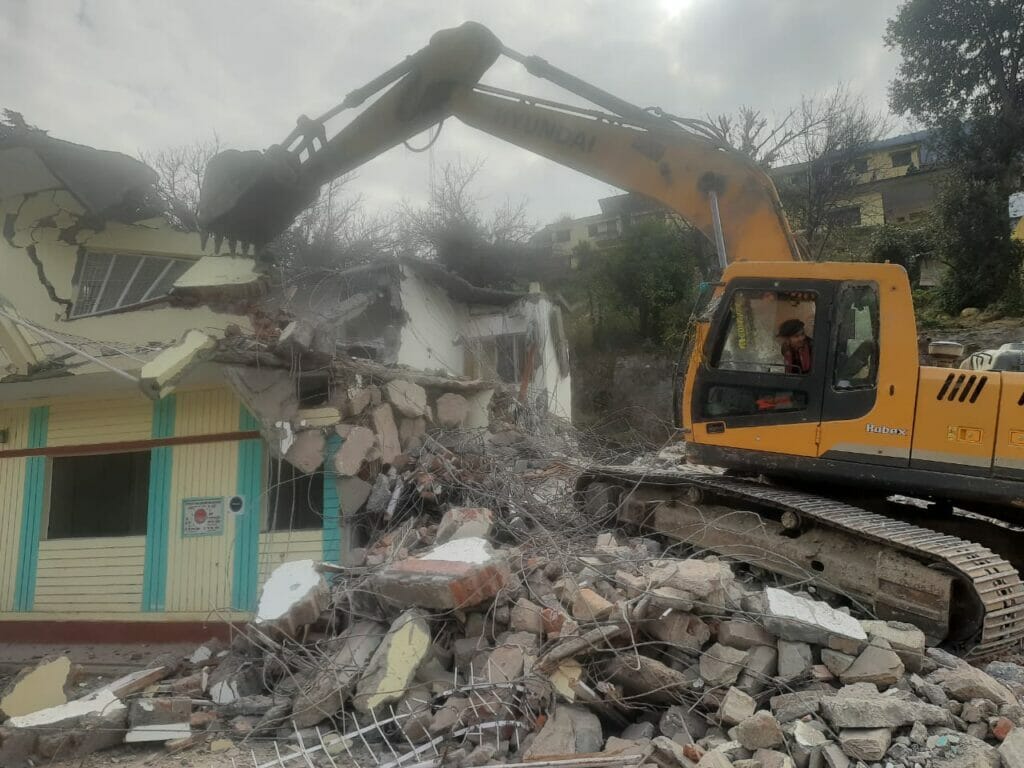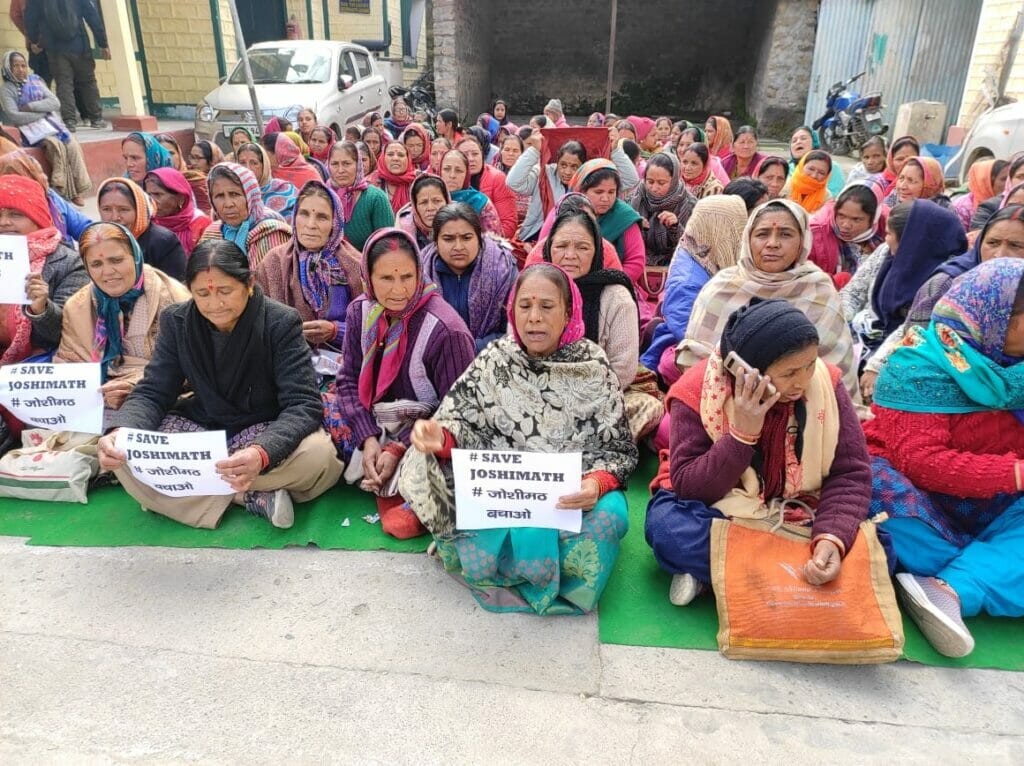The land in the hill towns, not just in Joshimath, is sinking. Unusual climate events are a distinct probability. Earthquakes cannot be ruled out, given that that the entire state of Uttarakhand lies in a highly sensitive seismic zone. All this adds up to the possibility of a worst case scenario in case of major natural disaster, which experts do not rule out, especially once the rains set in.
And the state government is ill prepared to meet such a calamity if it occurs.
One indication of this lack of seriousness is the proposal to appoint an engineer as the head of the Landslide Mitigation and Management Centre, instead of an eminent geologist. The setting up of such a centre was cleared by the state cabinet in August 2022. The proposed appointment has drawn flak from the scientific community.
Land subsidence, as happened in Joshimath and other places in Uttarakhand, is just one problem the people of the state face. The recent devastating earthquake in Turkey and Syria has again brought to the fore the dangers of a similar catastrophe in the Himalayas which is one of the most geologically fragile areas. More than 700 small intensity earthquakes occur beneath the Himalayas every year which point towards the vulnerability of the entire Himalayan region to such an occurrence.
Which underlines the need for the state, always prone to natural disasters, to be well prepared to meet any such eventuality. But there is little confidence that the state is taking the necessary steps to strengthen its disaster management systems.
Read more: That sinking feeling again: From Joshimath to Shimla via McLeodganj and Dharamshala
Recurring disasters, poor management
Although the state was the first in the country to have a separate disaster management ministry, past experience of disaster management shows that civilian administration virtually crumbled when faced with such an event. It was the personnel of the National level Disaster Relief Force, army, police and para-military personnel deployed who actually provided the needed relief to the affected population.
Uttarakhand has been facing natural disasters frequently. The state is seeing major road and other construction projects whose ecological effects have been repeatedly ignored, triggering natural disasters in the mountains in the shape of floods, landslides, earthquake, forest fires, cloud bursts or snow avalanches.
The fear is that the current year could see some or all of these disasters occurring. The scale of which could be unprecedented.

Claims versus reality
Past experiences have shown that any disaster in the mountains is more problematic to deal with, because of topography and inaccessibility to the affected areas. The past two earthquakes in the Uttarakhand region, namely in Uttarkashi in 1991 and Chamoli in 1999, had amply shown the inadequacy of the state government machinery to deal with such natural calamities. Rescue, relief and rehabilitation work by the local authorities was done in an unscientific and ad-hoc manner, often leaving victims to fend for themselves.
Similar is the situation at Joshimath presently. Successive governments have failed to learn any lessons from past experiences. Despite having a new ministry of disaster management, questions remain on how well the state is prepared to manage a disaster of bigger magnitude.
Uttarakhand State Disaster Management Authority officials claim they have trained people right up to the village panchayat level on what to do, particularly in case of an earthquake. Awareness and training campaigns and mock drills are regularly held at the ground level with an aim to cover all the villages of the state. Efforts are also on to have village level disaster management plans.
“We have been asked not to talk to media on the issue, only senior officials are authorised to talk,” said Piyush Rautela, Executive Director of Uttarakhand State Disaster Management Authority, who is well experienced in disaster management. Officials claim that equipment required for any disaster is already with the panchayats and SDRF, police, panchayat members and District Disaster Mitigation Officers who are regularly trained and oriented to meet any such eventuality.
Rapid urbanisation due to internal migration to district headquarters, towns and cities from rural areas and mushrooming of constructions on hill slopes has put many more human lives in danger in case of a quake. Especially the many buildings that have come up in the vulnerable seismic zones like Mussoorie, Nainital and Rajpur in the foothills of Mussoorie.
As per a survey of Uttarakhand State Disaster Management Authority, 19,000 government buildings including schools and hospitals are vulnerable to earthquake.
Read more: Joshimath residents literally shivering in cold, fear of what the future holds
There is no special disaster management plan keeping in view the state’s unique geographic and topographical conditions. Past experience has shown that people are left to the mercy of the elements during the crucial first 24 hours after such a disaster, as the civil machinery takes a long time to react. This was seen during the Kedarnath deluge in June 2013 and many other disasters of smaller magnitude, when no relief reached the victims in the first 24-48 hours.
State’s slow response
A performance audit report in 2015, prepared by the Comptroller and Auditor General (CAG) on the 2013 Kedarnath flash floods, blamed the state government of the time for being unprepared and failing to learn from previous natural disasters.
The report rapped the state government for its slow response which, it says, actually aggravated the disaster that caused widespread destruction in five hill districts.
Need of the hour
There is an urgent need to formulate a disaster management strategy for the hilly areas with active participation of the local communities taking into consideration the unique geographic conditions.
“The disaster management strategy should be community-oriented and should focus on primary schools where locals, teachers and villagers should be involved in preparing for any such eventuality,” said Padma Bhushan Dr Anil Joshi, head of Himalayan Environmental Science and Environmental Studies (HESCO), a voluntary body.
“The nature of the disasters striking any particular region should be identified and the vulnerable areas like landslide prone, seismically active, cloud burst or snow avalanche prone areas should be mapped and identified”.
Specialised scientific institutes like Geological Survey of India, Wadia Institute of Himalayan Geology, and specific departments of various universities particularly located in the hill states should come up with maps identifying the various disaster prone areas so that planners, officials and the public could be aware of the dangers.
These institutes can also act as centres for human resources development, providing specialised training to officials, employees, youth and women who can be roped in for help during a disaster. The training and skill development would prepare people for better management of the rescue, relief and rehabilitation efforts.

These agencies and groups should not only be made aware of the types of disasters likely to strike and the areas likely to be affected but provided training and orientation courses from time to time to deal with any kind of calamity.
The rural mountain areas require a different kind of approach since most of the villages are inaccessible and away from the main roads. It had been seen that the villagers found it extremely difficult to carry their injured to the road heads to be transported to the main hospitals. Similarly, a separate strategy should be adopted for the urban areas of the hill states, which are densely populated.
Disasters strike without warning. This fact calls for preparedness to be maintained at every level of government administration and voluntary sector. “The disaster preparedness in Uttarakhand needs to be spruced up,” says Anoop Nautiyal who heads an NGO Social Development of Communities (SDC). “We have the excellent ‘Orissa Model’ to emulate which worked exceptionally well to manage a natural disaster like cyclone. The preparedness should be in totality”. Nautiyal had earlier headed the emergency ambulance service 101 in the state.
The Uttarakhand State Disaster Management Authority (USDMA) and its’ earlier version, the Disaster Mitigation and Management Centre (DMMC) said that it has already trained thousands of personnel particularly among police and revenue officials, and holds regular 20-day training programme at the National Institute of Mountaineering, SSB Gwaldam and Himalayan Adventure Institute, Kempty.
The proof of that will lie in the response to a future disaster, which experts says, is inevitable.
Earthquake resistant housing techniques taught by Laurie Baker forgotten
It was the abandonment of traditional knowledge in using earthquake resistant techniques in building construction that led to have damage to life and property in the Uttarkashi 1991 and Chamoli 1999 earthquakess.
Well known architect, the late Laurie Baker, a staunch proponent of using low cost local materials in construction, had visited Uttarakhand thrice to share with villagers and local masons the techniques to build earthquake resistant houses using local materials. He held a workshop with 22 local masons at Budna village in Ghansali tehsil of Tehri Garhwal district (when)
Baker had also trained 15 masons at Joshimath in Chamoli district telling them to retain traditional wisdom in building houses. His practical wisdom and his sketches were collected and put together as a manual for constructing quake resistant and low cost houses in the Himalayan region. His techniques soon faced a major test when the Chamoli earthquake struck on March 29, 1999.
The houses built by built stood strong while so many other cement and steel building collapsed. Unfortunately, today few remember Laurie Baker or traditional wisdom in building houses.